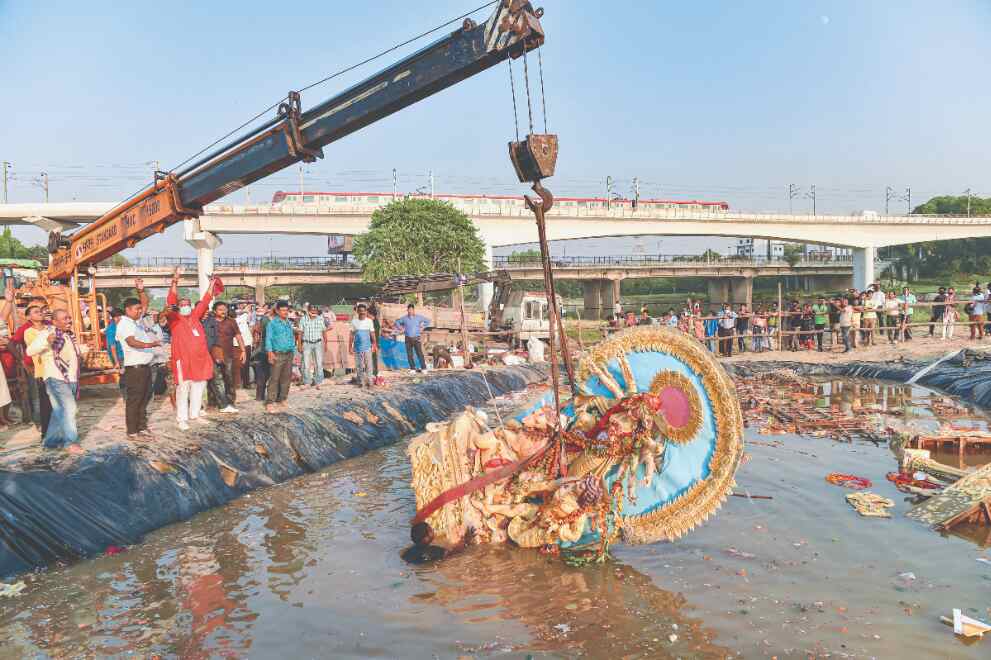Country celebrates Dussehra

New Delhi: Effigies of demon king Ravana, his son Meghnad and brother Kumbhakaran went up in flames on Dussehra marking the triumph of good over evil, unlike last year when celebrations were subdued because of rising cases of Coronavirus.
The four-day-long Durga Puja festivities also culminated on Friday, with idol immersion at rivers and water bodies.
Prime Minister Narendra Modi and Vice President M Venkaiah Naidu greeted people on the occasion of Vijaya Dashami or Dussehra on Friday.
"Greetings to everyone on the special occasion of Vijaya Dashami," Modi tweeted.
Naidu said may this festival bring peace, harmony and prosperity in the country.
"My warm greetings on the auspicious occasion of Vijaya Dashami. Dussehra is an occasion to remind us that we need to constantly quell the demonic forces within us and foster goodness and harmony," the Vice President Secretariat tweeted, quoting him.
With authorities keeping a hawk-eye vigil, the festivities were held following COVID-19 norms, and in several places Ravana effigies were burnt without firecrackers and events shown live on social media platforms.
In Uttar Pradesh's Mathura, however, Ravana was worshipped at a temple as the country celebrated Lord Ram's victory over the demon king.
The event was organised by the Lankesh Mitra Mandal at the temple on the banks of the Yamuna river.
In Punjab and Haryana as well as their common capital Chandigarh, huge effigies of the demon king Ravana were burnt.
In Chandigarh, crackers were not used in the effigies and sound effect of crackers was used digitally.
Festivities passed off peacefully amid tight security arrangements in different parts of Punjab and Haryana, officials said.
In Odisha, a handful of the state's Telugus in Berhampur town in Ganjam district held on to the fading 'Bommala Koluvu' tradition.
Traditionally celebrated by the Kamma community among the Telugus, 'Bommala Koluvu' is an exhibition of dolls and decorative pieces from the first day of Navaratri till Dussehra, which fell on Friday this year.
Earlier, the tradition saw massive participation of Telugus in the southern Odisha town but it is gradually fading as many children from these families are outside the state for study or jobs.
"We display the dolls, mostly deities or traditional figurines, from various states and across religions during the nine-day festivities," 57-year-old J Sailaja said.
She took about 2-3 days to arrange around 1,200 idols in a 12 by 15 feet room with illumination while her husband helped arrange their house.
"None of the items are made of plastic. Most of the dolls are made of wood, cloth, brass and silver. Several of these have been passed on through generations, while we have bought many from different states and countries," her husband Dr J Narayan Rao said.
He said that his family has been celebrating the tradition in their house for the last three years after a gap of some years.
In Karnataka's Mysuru, the curtains came down on the 10-day Dasara or Dussehra festival with the spectacular 'Jamboo Savari' procession of elephants marking the grand finale.
However, the Mysuru royal palace will continue to shine at night for the next nine days with Chief Minister Basavaraj Bommai ordering to light up the palace for the tourists.
Held under the shadow of COVID-19, there were many restrictions due to which the usual gathering of large number of people was missing as the administration had restricted visitors and issued limited passes.
However, in keeping with the centuries old tradition, all the rituals were held abiding by the COVID-19 norms.
The day also saw protests in some parts of the country.
The Samyukt Kisan Morcha burnt a multi-headed Ravana-like effigy of Prime Minister Modi having faces of Home Minister Amit Shah and others in Jaipur to protest against the October 3 violence in Uttar Pradesh's Lakhimpur Kheri.
In Rajasthan's Dholpur, five people drowned in the Parvati river during idol immersion.



